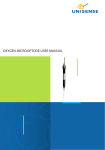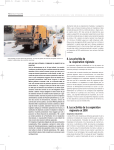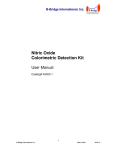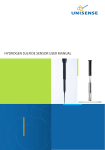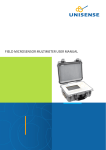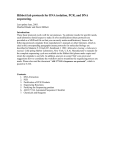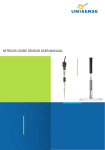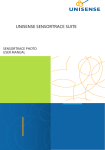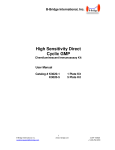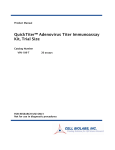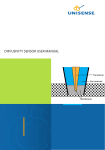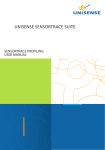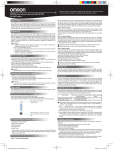Download NO Microsensor Manual
Transcript
NITRIC OXIDE SENSOR USER MANUAL NITRIC OXIDE SENSOR USER MANUAL UNISENSE A/S Nitric oxide sensor user manual Copyright © 2014 · Unisense A/S Version January 2014 TABLE OF CONTENTS NITRIC OXIDE SENSOR USER MANUAL . . . . . . . . . . . . . . . . . . . . . . . . . . . . . . . . . . . . . . . . 1 WARRANTY AND LIABILITY . . . . . . . . . . . . . . . . . . . . . . . . . . . . . . . . . . . . . . . . . . . . . . . . . . . 6 CONGRATULATIONS WITH YOUR NEW PRODUCT! . . . . . . . . . . . . . . . . . . . . . . . . . . . . 7 Support, ordering, and contact information 7 OVERVIEW . . . . . . . . . . . . . . . . . . . . . . . . . . . . . . . . . . . . . . . . . . . . . . . . . . . . . . . . . . . . . . . . . . . . 9 Working principle 9 GETTING STARTED . . . . . . . . . . . . . . . . . . . . . . . . . . . . . . . . . . . . . . . . . . . . . . . . . . . . . . . . . . 10 Unpacking a new sensor Grounding the set-up Polarization Pre-polarization Calibration 10 10 11 11 12 STOCK SOLUTIONS AND NO DONORS . . . . . . . . . . . . . . . . . . . . . . . . . . . . . . . . . . . . . . . 14 MEASUREMENTS . . . . . . . . . . . . . . . . . . . . . . . . . . . . . . . . . . . . . . . . . . . . . . . . . . . . . . . . . . . . 17 Mounting of the sensors Interference 17 18 ADVANCED USE OF THE NO SENSORS . . . . . . . . . . . . . . . . . . . . . . . . . . . . . . . . . . . . . . . 19 STORAGE AND MAINTENANCE . . . . . . . . . . . . . . . . . . . . . . . . . . . . . . . . . . . . . . . . . . . . . 20 Storage Cleaning 20 20 REFERENCES . . . . . . . . . . . . . . . . . . . . . . . . . . . . . . . . . . . . . . . . . . . . . . . . . . . . . . . . . . . . . . . . . 21 TROUBLE SHOOTING . . . . . . . . . . . . . . . . . . . . . . . . . . . . . . . . . . . . . . . . . . . . . . . . . . . . . . . 22 WARRANTY AND LIABILITY Notice to Purchaser This product is for research use only. Not for use in human diagnostic or therapeutic procedures. Warning Microsensors have very pointed tips and must be handled with care to avoid personal injury and only by trained personnel. Unisense A/S recommends users to attend instruction courses to ensure proper use of the products. Warranty and Liability The NO microsensor is covered by a 90 days limited warranty. Microsensors are a consumable. Unisense will only replace dysfunctional sensors if they have been tested according with the instructions in the manual within 14 days of receipt of the sensor(s). The warranty does not include repair or replacement necessitated by accident, neglect, misuse, unauthorized repair, or modification of the product. In no event will Unisense A/S be liable for any direct, indirect, consequential or incidental damages, including lost profits, or for any claim by any third party, arising out of the use, the results of use, or the inability to use this product. Unisense mechanical and electronic laboratory instruments must only be used under normal laboratory conditions in a dry and clean environment. Unisense assumes no liability for damages on laboratory instruments due to unintended field use or exposure to dust, humidity or corrosive environments. Repair or Adjustment Sensors and electrodes cannot be repaired. Equipment that is not covered by the warranty will, if possible, be repaired by Unisense A/S with appropriate charges paid by the customer. In case of return of equipment please contact us for return authorization. For further information please see the document General Terms of Sale and Delivery of Unisense A/S as well as the manuals for the respective products. 6 CONGRATULATIONS WITH YOUR NEW PRODUCT! Support, ordering, and contact information The Nitric Oxide (NO) microsensor is a miniturized sensor for measuring the partial pressure of NO gas in the nanomolar range. If you wish to order additional products or if you encounter any problems and need scientific/technical assistance, please do not hesitate to contact our sales and support team. We will respond to your inquiry within one working day. E-mail: [email protected] Unisense A/S Tueager 1 DK-8200 Aarhus N, Denmark Tel: +45 8944 9500 Fax: +45 8944 9549 Further documentation and support is available at our website www.unisense.com. REPLACEMENT OF SENSORS Unisense will replace sensors that have been damaged during shipment provided that: • The sensors were tested immediately upon receipt in accordance with the delivery note and the manual • The seal is still intact. • The sensors are returned to Unisense for inspection within two weeks. • The sensors are correctly packed for return to Unisense, in accordance with the note included in the sensor box. 7 THIS MANUAL COVERS THE FOLLOWING SENSORS NO10 (tip diameter <20 µm) NO100 (tip diameter 70-110 µm) NO-MR (designed for use with microrespiration system) NO-N (Needle-type NO sensor) NO-R (NO sensor with protective cap) NO-spec - NO sensors with customer specified specifications RECOMMENDED METERS FOR NO SENSORS One-channel meter: Microsensor Monometer Multi-channel meter: Microsensor Multimeter 8 OVERVIEW The Unisense nitric oxide (NO) microsensor is designed for research applications within physiology, biotechnology, environmental sciences, and related areas. The Unisense NO microsensor can be made with • a small tip size (10 μm), which ensures excel- WARNING Unisense sensors are neither intended nor approved for use on humans lent response time and insignificant stirring sensitivity and makes it possible to make reliable and fast measurements with high spatial resolution • a larger tip size (>100 μm) which allows for low detection limit (approx. 2-3 nM) For non-destructive measurements, the sensor should be designed to have a small tip; for other applications the sensor is designed for maximum sensitivity. Working principle The NO sensor is a miniaturized Clark-type sensor which must be connected to a high-sensitivity picoammeter. The measuring anode inside the sensor tip is polarized against an internal reference electrode by the picoammeter. Driven by the external partial pressure, NO from the environment will penetrate the sensor tip membrane and reach the anode surface where it is oxidized. The picoammeter converts the resulting oxidation current to a voltage signal. The Unisense NO sensor has an extremely low consumption compared to other standard NO sensors. The maximum consumption (i.e. for the NO100) is 935 femtomol/hour which corresponds to 0.1%/hour in a 1ml 0.1uM NO sample. 9 GETTING STARTED Unpacking a new sensor When receiving a new NO microsensor, remove the shockabsorbing grey plastic net. Please do not remove the seal and protective tube before the following steps are successfully completed. WARNING WARNING WARNING WARNING WARNING It is extremely important to ground the NO sensor before use. Otherwise the sensor is very susceptible to electrical disturbances and in some cases will be damaged. Please read the information and directions in this manual and contact Unisense if you are in doubt of what to do. Grounding the set-up Before connecting the NO sensor, it is important to ground the set-up, both the measurement media and the picoammeter. Grounding the set-up means to stabilize its electrical potential to avoid noisy signals and/or damage to the sensor. Grounding is done by connecting any media/liquids the sensor will touch to the ground connection of the picoammeter using the provided wire, and connecting the ground plug of the picoammeter to an earth line. An earth line can often be found in electrical outlets, alternatively a good electrical connection to a water pipe may be used. If an earth line is not available, at least keep media and picoammeter ground connected. Technical details The tip membrane of a microsensor serves as an electrical barrier which minimizes the effect of electrical disturbances. If, however, a sufficiently high electrical potential has built up across the membrane, the resistance is not high enough to prevent a discharge of electricity across the membrane. Often this happens when a person carrying electrical charges touches the set-up. The discharge across the membrane can cause a permanent 10 WARNING Do not remove the seal and protective plastic tube before these steps and calibration are successfully completed. breakdown of the electrical resistance of the membrane and subsequently, electrical noise e.g. 50/60 Hz noise from mains power installations can then affect the signal severely. As NO sensors have particularly thin membranes, they are more prone to this problem than other sensors. See also the Troubleshooting section. Polarization The signal from the NO sensor is a small current in the picoampere range. Therefore the NO sensor must be connected to a polarizing picoammeter (e.g. a Microsensor Monometer, a Microsensor Multimeter, or the Unisense PA2000). NO sensors should be polarized at +1.25 V. The polarization voltage is set in the amplifier. For details on how to set and check the polarization, consult the user manual of the picoammeter to be used. If you are using a PA2000 amplifier, please check the polarization voltage before connecting the sensor, since incorrect polarization may destroy the sensor. Pre-polarization When the sensor is not in use, NO will build up inside the electrolyte. This must be removed order to obtain a stable zero current as background for calibrations and measurements. and thus stable operation of the sensor is possible. Therefore, a period of polarization is necessary before you can use the sensor. This is called the pre-polarization period. When the NO sensor is connected to the picoammeter and polarization of the sensor is initiated, the signal will be very high, drop rapidly over the first few minutes, and then drop more slowly. For new sensors and sensors that have not been in use for several days, it takes up to 24 hours for the signal to stabilize. After shorter periods without polarization, the sensor should be polarized until it has exhibited a stable signal for 10 minutes. If the signal does not stabilize below 20 pA at room temperature, please look in the ‘Trouble-shooting’ section of this manual. 11 Calibration Before concentration measurements can be performed, a calibration should be performed. The NO sensor responds linearly to NO from zero up to a maximum linear concentration. Thus, a two-point calibration is sufficient. The maximum linear concentration depends on the application the sensor is designed for. The calibration standards should be within the linear range for the sensor in question and cover the expected concentration range to be measured, e.g. zero NO (0% atm.) and 1 μM. Using NO stock solution Please see the following section “Stock solutions and NO donors” for instruction on preparation. Zero reading Note the signal, S0, in water without any NO (or interferents). (Note: Be careful if you try to use gas-sparged water which has contained NO. NO will convert to NO2- in the presence of oxygen and if the water is acidic, HNO2 is formed. HNO2 interferes on the NO sensor and is not easily removed by sparging the water). High reading NO will react spontaneously with oxygen, so an NO calibration solution should be made in an anoxic environment. A continuously anoxic solution can be maintained in the following manner: Get a vessel – preferably made of glass – with a lid with two holes in it (e.g. Unisense CAL300). One hole is for sparging with oxygen free gas (e.g. N2 gas), the other hole is for inserting the NO sensor. The vessel is filled ¾ with neutral pH buffered water, and there is thus a headspace under the lid. The sensor is placed through the sensor hole in the lid with its tip a few cm inside the buffer. The oxygen-free gas is led through the gas-sparging hole through a long pipe or needle that opens at the bottom of the vessel. Bubbling oxygen-free gas through the buffer solution will remove all oxygen. The gas should stream fast enough to effectively flush the headspace, preventing atmospheric oxygen from entering through any of the holes in the lid. For the Unisense calibration chamber CAL300, 5 minutes of bubbling at a rate of 0.5 12 IMPORTANT Calibration must be performed after pre-polarization when the sensor signal has stabilized. Always use a calibration solution with the same temperature and salinity as the sample solution. L gas per minute is sufficient to drive out 99% of the oxygen. After the buffer is stripped of oxygen, the gas pipe is retracted somewhat such that it opens in the headspace. An small volume of an NO stock solution (see Stock solution and NO donors section below) is injected into the buffer. The buffer is stirred briefly to distribute the NO evenly. Stirring can be done with a) a glass rod through the gas flushing hole, b) brief bubbling with the gas pipe, or c) with a stirrer magnet when the vessel is placed on a stirrer plate. The continued gas flow in the headspace will keep oxygen out, but will only slowly remove NO from the buffer (as opposed to bubbling which will remove NO quickly). The high calibration reading (S1) is noted, corresponding to the concentration (C1) calculated from the stock concentration and the dilution ratio. To convert a signal S from partial pressure to the corresponding concentrations of NO (C), perform a linear conversion: C = (C1 * S -C1S0)/ (S1-S0) WARNING Bubbling of water with gas may cause the water to change temperature due to the gas temperature or evaporative cooling. Monitor the temperature to find a suitable bubbling rate, which does not does not change the water temperature significantly. If you use Unisense software, the calibration calculations can be performed by the software. Consult the software manual for details. Check and repeat calibration at appropriate time intervals to ensure that all measurements can be calibrated to correct concentrations. When the sensor is new, you may need to calibrate more often, while an older extensively used sensor may require calibration only every 24 hours or less. To minimize the need for calibration, it is recommended to keep the sensor polarized between measurements. The membrane permeability of NO microsensors changes with time, so a change in signal of up to 50% may occur over months. This does not affect the quality of the measurements as long as the sensor is regularly calibrated. Using NO donors Some researchers prefer making calibrations with so-called NO donors. We will not describe a procedure here. However, references can be found in the Stock solutions and NO donors section. 13 STOCK SOLUTIONS AND NO DONORS There are several ways to prepare an NO stock solution 1. Using NO gas: a. A sealed vial is half-filled with distilled water or buffer, flushed with argon to remove oxygen, and the headspace is finally vacuum-treated. NO gas from a pressure gas tank is bubbled through a washing bottle, containing 1 M NaOH. The bottle captures impurities in the form of N2O3 and N2O4 gas. The gas streams long enough to flush all oxygen out. After the washing bottles, the gas is lead through a needle. The needle is led to penetrate the septum in the vial, filling the headspace with a slight overpressure of NO. Subsequently, the vial is shaken to equilibrate the headspace NO with the water/buffer, before the surplus pressure is removed by puncturing the membrane. Ref: Methods in Molecular Biology, Vol. 100, Nitric Oxide Protocols. Ed. Michael A. Thitheradge, Humana Press Inc., Totowa NJ., p.232: b. A researcher implements the above principle in the following way: bubbles NO gas from a pressure gas tank through two washing bottles in series, containing 5 M NaOH. These bottles capture impurities in the form of NO2 and NO3 gas. After the washing bottles, the gas is lead through a long needle 14 that penetrates a septum in a vial. The vial has a few ml distilled water inside and the NO gas bubbles through this water. A second needle through the septum leads from the headspace to the exterior to allow the gas to escape. The set-up is kept in a fume hood. Bubbling for a approx. 15 minutes results in a clean saturated stock solution of NO in the vial. This stock is diluted for calibration standards. After the NO production, the system is flushed for 45 minutes with Argon, if NO is left in the system it will attack rubber tubing. 2. Chemical NO synthesis: Another alternative is NO synthesis from NaNO2 with the following procedure: Concentrated H2SO4 is slowly added to a N2-flushed mixture of saturated NaNO2 and KI. This evolves NO gas which is passed through a wash bottle with 10 M NaOH to remove traces of NO2. The purified NO gas is captured in a vial with a membrane which contains a few ml of distilled water. A second needle through the septum leads from the headspace to the exterior to allow the gas to escape. Ref: Diab et al. 2005. Electrochemical nitric oxide sensor preparation: a comparison of two electrochemical methods of electrode surface modification. Bioelectrochemistry 66:105-110. 15 As an alternative to NO stock solutions, some researchers use the a compound that can decompose and release NO (NO donor). 1. Ref: Richardson et al. 2006. The nitrosative stress response of Staphylococcus aureus is required for resistance to innate immunity. Molecular Microbiology (2006) 61(4), 927–939: “Nitric oxide donating compounds used in this study were obtained from Alexis Biochemicals (San Diego, CA). Diethylamine NONO-ate (DEA/NO, t1/2 = 2 min), Proline NONO-ate (ProliNO, t1/2 = 1.8 s), and Diethylethylenediamine NONO-ate (NOC-12, t1/2 = 100 min) were dissolved to 500 mM final concentration in 0.01 N NaOH and stored at -80°C. SNAP was resuspended to a final concentration of 500 mM in DMSO and aliquots were stored at -80°C. The conjugate donor compounds diethylamine (Sigma D-0806), proline (Sigma P-0380), diethylethylenediamine (Aldrich 126942), and NAP (Aldrich A19008) were diluted to same concentrations as cognate NONO-ates in like solvents and stored at -80°C.” 2. For further information on the SNAP method: Ref: Xhang et al. 2000. Novel Calibration Method for Nitric Oxide Microsensors by Stoichiometrical Generation of Nitric Oxide from SNAP. Electroanalysis 12(6):425-428. 16 MEASUREMENTS Before doing microscale measurements, the seal must be broken and the protective tube removed. NOTE: this terminates Unisense’s warranty. Mounting of the sensors Although the Unisense microsensors are made of glass, the tip is flexible and can bend slightly, and the sensors are surprisingly robust in use in coarse substrates. However, lateral movements of the sensor when the tip is in contact with a solid substrate may easily cause the tip to break. Also, due to the small size of the microsensor tip and to the steepness of gradients in many environments, even a displacement of the sensor tip of few microns may change its environment. Therefore, we recommend that measurements are performed only in a stabilized set-up free of moving or vibrating devices. We recommend the Unisense lab stand LS18 and the Unisense micromanipulator MM-33 (or double MM33-2) for laboratory use. For in situ use we recommend our in situ stand (IS19) and a micromanipulator or our automated in situ profiling instruments. WARNING WARNING WARNING WARNING WARNING It is extremely important to ground the NO sensor before use. Otherwise the sensor is very susceptible to electrical disturbances and in some cases will be damaged. Please read the information and directions in this manual and contact Unisense if you are in doubt of what to do. Electrical noise The signal of a NO microsensor is very small (10-14 to 10-10 ampere). Although both the Unisense amplifiers and microsensors in general are relatively resistant to electrical noise from the environment, electrical fields may interfere with the sensor signal. NO microsensors are more susceptible to electrical noise than e.g. IMPORTANT Always introduce and retract the NO microsensor axially using a micro manipulator and a stable stand when measuring in solid or semisolid substrate like sediment, tissue, biofilms, microbial mats, etc. IMPORTANT To resolve the very small concentrations that are most often of interest, it is very important to eliminate electrical noise as much as possible. This can be done by grounding the set-up (if you have a PA2000, you can place an analog filter on it. 17 oxygen microsensors, so it is necessary to ‘ground’ the set-up. This is done by creating an electrical connection between the Ground connection of the picoammeter and the sample to be studied (tissue, sediment core water etc.). Also, unnecessary electrical/ mechanical equipment should be switched off and touching components of the set-up during calibrations and measurements should be avoided. On suspicion of sensor damage, repeat calibration and consult ‘Trouble-shooting’. Interference The following compounds and physical parameters are known to exhibit interference on the NO microsensor: HNO2, H2S, light, temperature. Keep updated on reported interferents on our web page. The graph shows a NO sensor response to sequential addition of 12nM of NO. Data points were taken every second. Each of the shown points is the running average of 10 measured data points. 18 ADVANCED USE OF THE NO SENSORS Unisense can construct NO sensors for customer requested applications at additional costs. The most frequent construction options are described at our website. Options include customer specified modifications, response time, stirring sensitivity, pressure tolerance, range, and detection limit. If your requirements for a NO sensor are not described on our website, please contact [email protected] for further options and prices. Examples of advanced applications • Respiration/production rates in small samples in Unisense microrespiration chambers MR-Ch • Measurements of NO under high external pressure e.g. in closed pressurized systems or in the deep sea • Flow-through cell measurements 19 STORAGE AND MAINTENANCE Storage Store the sensor in the protective plastic tube used for shipping. The NO microsensor can be stored with the tip exposed to water or air. The room in which the NO microsensor is stored should be dry and not too hot (10-30°C). If the sensor is used regularly it can be stored polarized connected to a Unisense Meter. Cleaning The sensor tip can be sterilized with ethanol. During use, different compounds may deposit on the sensor tip, resulting in a less sensitive and slower sensor response. Depending on the substance, different solutes can remove the deposit. The standard procedure is to rinse with 96% ethanol, then rinse with 0.01 M HCl and then rinse with water; this will remove most substances. Alternatively it is possible to rinse with 0.1M NaOH, isopropanol, or detergents. In some cases the deposits need physical abrasion to be removed; contact Unisense for advice on this. Solubility of NO in water: T degrees C NO solubility 15 2,31 mM 20 2,10 mM 25 1,92 mM 30 1,78 mM 35 1,66 mM Reference: SOLUBILITY OF SELECTED GASES IN WATER by L. H. Gevantman, CRC Handbook of Chemistry and Physics, 92nd Edition 20 REFERENCES • Aamand, R., et al. 2009. Generation of nitric oxide from nitrite by carbonic anhydrase: a possible link between metabolic activity and vasodilation. Am J Physiol Heart Circ Physiol 297:H2068–H2074. • Barak, Y, et al. 2010. Role of nitric oxide in Salmonella typhimurium-mediated cancer cell. BMC Cancer 10(1):146. • Ettwig, K.F. et al. 2010. Nitrite-driven anaerobic methane oxidation by oxygenic bacteria. Nature 464:543-548. • Pryor, W. et al. 2006. Free radical biology and medicine: it’s a gas, man!. Am J Physiol Regulatory Integrative Comp Physiol 291:491-511 • Schreiber, F. et al. 2008. Nitric Oxide Microsensor for High Spatial Resolution Measurements in Biofilms and Sediments. Anal. Chem. 80(4) 1152–1158 • Schreiber, F. et al. 2009. Mechanisms of transient nitric oxide and nitrous oxide production in a complex biofilm. The ISME Journal 3, 1301–1313. • Schreiber, F. et al. 2010. Denitrification in human dental plaque. BMC Biology 8(1):24. • Wadsworth, R. et al. 2006. Physiologically Relevant Measurements of Nitric Oxide in Cardiovascular Research Using Electrochemical Microsensors. J Vasc Res 43:70–85. 21 TROUBLE SHOOTING Problem Possible cause Solution High and drifting signal Gas bubbles present inside the sensor tip due to short circuit or electrical shock. Degas water by boiling and subsequent cooling or by 10 minutes of vacuum treatment. Immerse the sensor tip for 20 min in the degassed water. Repeated or prolonged treatment may be necessary. Problem The sensor tip is broken Solution Replace the NO microsensor. Problem Signal very low Possible cause Inactivation of the anode surface. Solution Replace the NO microsensor. Problem Signal constantly very low and no response to NO Possible cause Solution Problem Possible cause Solution Gas bubbles present inside the tip of the sensor causes a disruption in the electrolyte. Degas water by boiling and subsequent cooling or by 10 min. of vacuum treatment. Immerse the sensor tip for 20 min in the degassed water. Repeated or prolonged treatment may be necessary. Slow response. Insoluble compounds deposited at the sensor tip. Consult the “Cleaning” section. Problem Slow response. Especially needle sensors Possible cause A gas bubble is trapped at the needle tip. Solution Remove the gas bubble by gentle movements of the sensor Problem Unstable signal or the signal fluctuates if the set-up is touched or equipment is introduced in the medium you are measuring in Electrical disturbance of the sensor through the tip membrane Ground the set-up using the blue grounding cable supplied with the picoammeter. Connect the reference plug on the picoammeter (blue plug) with the medium you are measuring in. Please see directions on page 10 of this manual. Possible cause Solution If you encounter other problems and need scientific/technical assistance, please contact [email protected] for online support (we will answer you within one workday) 23 27 UNISENSE, DENMARK www.unisense.com · [email protected]




























